We found the satellite LIGHTHOUSE in orbit (no)
Dear friends!
We built, built and finally built!

On July 14, 2017, at 9:36 Moscow time, launch vehicle Soyuz-2.1a with a payload from the large satellite Kanopus-V-IK and 72 small spacecraft was launched from site No. 31 of the Baikonur cosmodrome with a payload from the large satellite Kanopus-V-IK. A new record for the domestic cosmonautics in terms of the number of spacecraft simultaneously launched into space.
Video 1
Video 2
The exit to orbit and satellite breeding was provided by the “Frigate” upper stage. 2.5 hours after the launch, at 12:15 Moscow time , the Mayak satellite, the first Russian satellite created by the hands of enthusiasts, set off for free flight from the transport and launch container!
After another 7.5 hours, when the satellite flew over the night Baikonur, the project team went ashore to Syrdarya to find it visually. At estimated times, both the satellite developers and unfamiliar viewers saw bright, non-periodic flashes of the satellite. Our joy knew no bounds!
But!
But later it turned out that those were not the flashes! We confused the direction of arrival of the device, looked the other way and saw flashes of something else. It's funny that we looked to the south, because we thought that once the rocket flew to the north before our eyes, then, having rounded the Earth, it would arrive from the south. We did not take into account that 10 hours after the start, the Earth will have time to turn around its axis of rotation and will substitute us to the orbit from the other side :)
And then we will tell you how the “Mayak” project team was looking for its satellite in the sky, about how it seemed to be found, and how you can participate in the search with us.
Cluster launch
“Beacon” is one of 73 vehicles that went into orbit that day. Many satellites of that launch are no bigger than a shoebox, and therefore it is quite difficult to find them in orbit. Fortunately, not only space enthusiasts are interested in space satellites, but also the military. In Russia, we have the Main Space Intelligence Center , in the USA there is NORAD , which maintain their catalogs of space objects more than 5 cm in size. Our old military men keep their catalog a secret, the American ones publish most of it here , with the exception of their secret satellites.
And today, 3 days after launch, NORAD published data on our launch. In this long list, everything below the “Canopus-V-IR” satellite is our 72 satellites. The data on the orbits of the spacecraft are given in the list in the format of two-line elements, TLE (the specification can be found here ).
Which of the Mayak satellites?
Since the number of objects in the NORAD catalog corresponds to the number of satellites announced for launch, we assumed that all satellites, including “Mayak”, were regularly separated from the upper stage and made free flight. Also Roscosmos, and NPO them. Lavochkin confirmed that the work of “Frigate” was held regularly and all satellites are launched into target orbits. And then we were faced with the task of determining which of these satellites is ours.
We reasoned as follows:
- The satellites were output in three batches. The first was separated “Kanopus-V-IK”, then a group of 24 small devices, the last were separated by the Flock spacecraft. “Beacon” was in the second group, so its catalog number is from 42826 to 42849. These are just 24 vehicles with orbits with similar inclination values.
- We looked at the description of the TLE format and found, in addition to the orbit elements, also the parameters No. 9 “The first derivative of the mean motion (acceleration) divided by two” and No. 11 “The drag coefficient”. In our opinion, these parameters characterize the magnitude of changes in orbital parameters over time. Roughly speaking, the more these parameters are, the faster the satellite slows down.
- Yeah, we thought, you can try to find the “Lighthouse” for its rapid decline. On the fingers, we estimated the ballistic coefficients of “Mayak” and our fellow travelers. We had about 1 m ^ 2 / kg, and for all other devices - no more than 0.01 m ^ 2 / kg. So, in this sense, “Beacon” is unique, and this feature can be used. The ballistic coefficient is the ratio of the cross-sectional area of the satellite to its mass. A large and lightweight satellite, like ours, should be the fastest to brake;)
- Looking through the numbers from 42826 to 42849, we found one object with extreme values of these parameters! This is 42830 or 2017-042F according to international classification. If the values are the biggest, then this means that its orbit evolves the fastest, and it’s the fastest of all fellow travelers!
We thought it was a “lighthouse” and its pyramid was open!

* The trajectory line indicated by the dotted line is the part of the orbit in which the satellite is in the shadow of the Earth.
And exactly what is he?
Of course, such reasoning is very approximate. A few more nights have to pass in order for observers, amateurs and professionals to find the 2017-042F object in the sky, build its brightness curves (its brightness versus time). In addition, NORAD should produce several TLE sets, in which it should be seen that the 2017-042F is reduced faster than others.
Therefore, we urge the observers to follow the “Mayak” spans, inform us, the project team, the results of their observations and participate in the analysis of the data obtained in every way!
How now to find him in the sky !?
Unfortunately, the previously planned special KosmoMayak mobile application did not meet our functional expectations. While the application is being quickly reworked, we recommend using one of the special applications for observing celestial objects on celestrak.com .
You can choose an application suitable for your system - Windows, iOS, Android, etc.
The following are more detailed settings for several free applications that seemed to us the most convenient and functional.
Android
For Android, we recommend using the SatOrbit application. When you first start the application will download the actual data on the orbits of all observed spacecraft. Further, the data will be updated automatically several times a day. After that, you need to specify your location in the settings. If the program can not determine the location by GPS, you can enter the coordinates manually.
For Moscow, you must enter:
Latitude: 55.7522200 °
Longitude: 37.6155600 °
Height: 144 m
After that, you can specify the ID of the observed satellite, for the BEACON it is 2017-042F . Now only this satellite and its orbit, speed and visibility data will be visible on the map.
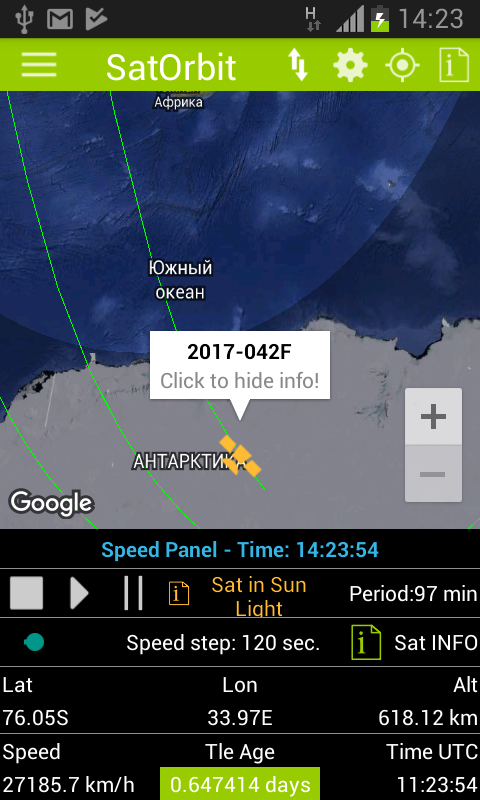
Continued ...
You can choose a convenient mode of observation, on a flat map, in 3D, etc.

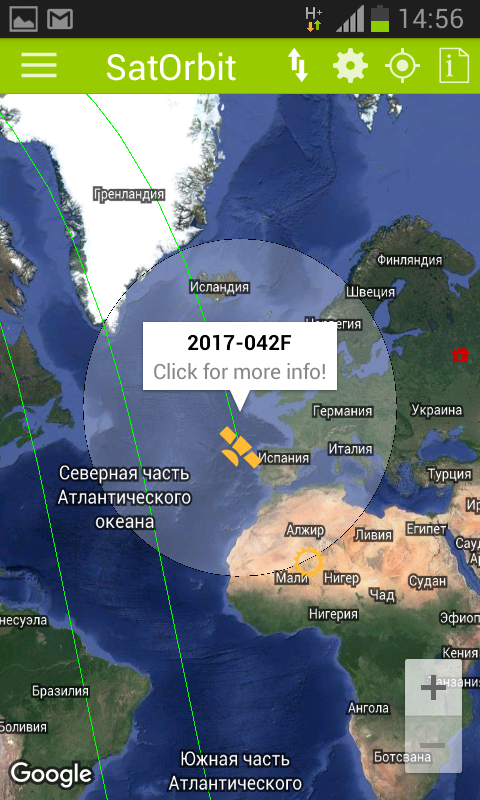
* A gray circle indicates the intended scope of the satellite.
To find out the near future visibility of the LIGHTHOUSE, go to the section “Pass View”. After the initial data processing, the program will show a list of the closest flights of the satellite near your location with the indication of the time of flight.

If you go to a specific time, the satellite flight path, as well as the graph of the calculated brightness and peak visibility will be displayed on the map.
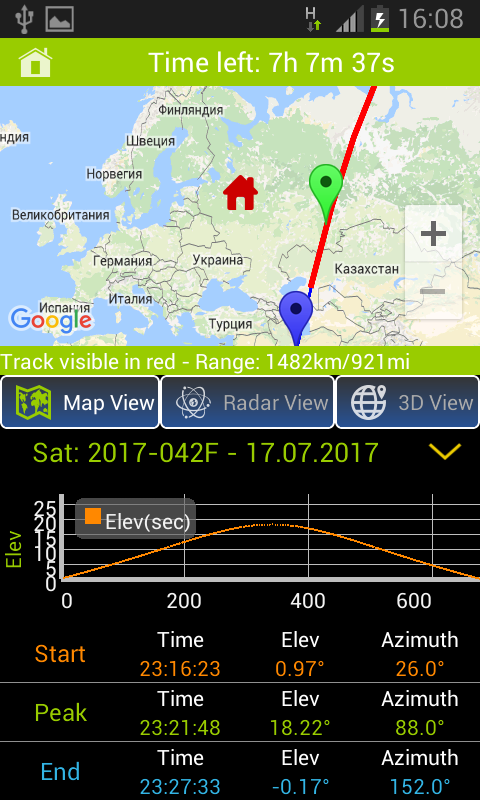
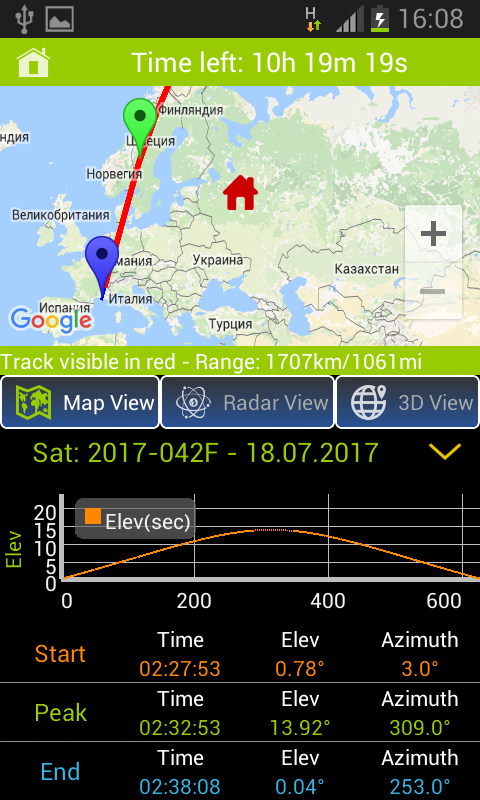



* A gray circle indicates the intended scope of the satellite.
To find out the near future visibility of the LIGHTHOUSE, go to the section “Pass View”. After the initial data processing, the program will show a list of the closest flights of the satellite near your location with the indication of the time of flight.

If you go to a specific time, the satellite flight path, as well as the graph of the calculated brightness and peak visibility will be displayed on the map.



iOS
For iOS, you can use the pxS SatelliteTracking application. Its interface is somewhat strange, but this is offset by good features.
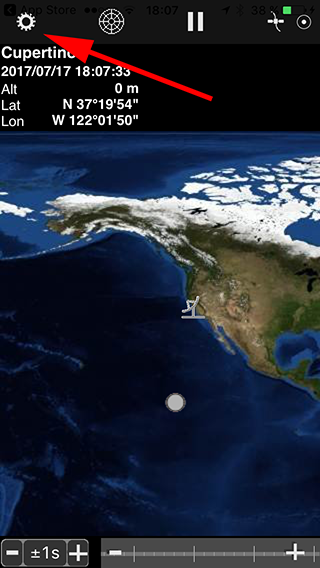
We start and immediately go to settings:
Continued ...
By default, the application shows the ISS (ISS), delete. Click on the “TLE” icon (after loading the database it will turn into “Sites”).
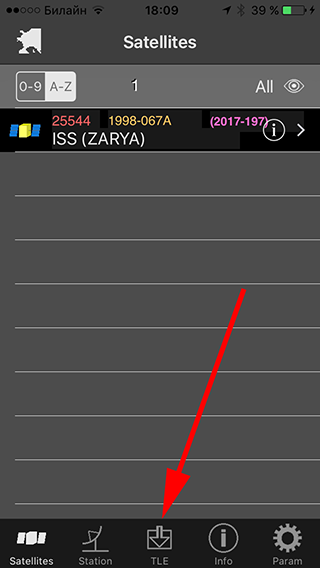
Scroll down the list to the record “Last 30 days launches” (this is the device from the last launches in 30 days) and go to it.
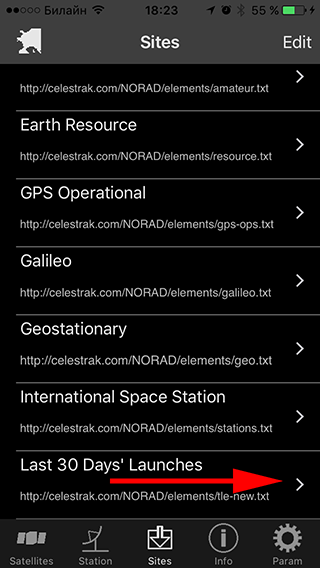
Click on the “refresh” icon at the top, the download of the database of recently launched satellites will begin.
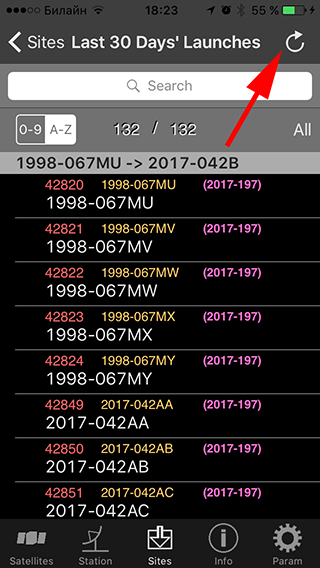
Enter in the search box ID Beacon - 2017-042F
We click on the empty field on the right, a check mark appears.
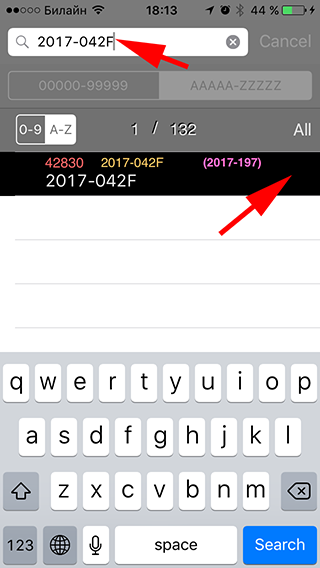
Everything, now the application is configured to display our satellite!
Next, we need to specify a point on the globe where we are. Go to the Station tab below.
By default there are Cupertino and Paris - click “Edit”.

We demolish Cupertino and Paris (if you are, of course, not there) and click “New Station” (meaning observation station).

We click on the location icon (iphone will ask to enable geolocation detection - we allow), we wait until the coordinates are determined, after a couple of seconds we press the “Save” button.
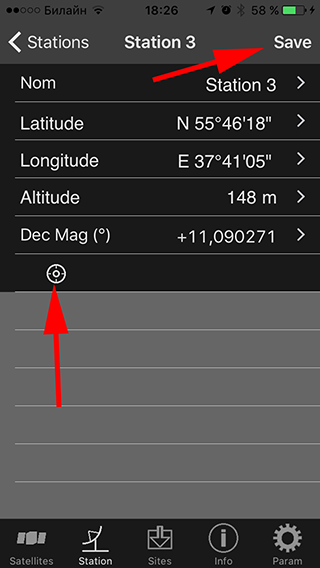
Now let's see the time of the visible passage of the Beacon over our location.
To do this, go to the “Satellites” tab, one of our satellites will be displayed there (and the ISS, if you have not deleted it). Make sure there is a yellow-blue satellite icon to the left of the Beacon - this displays it on the map. If not, click to the left of the name, then click on the “i” icon to the right of the satellite.
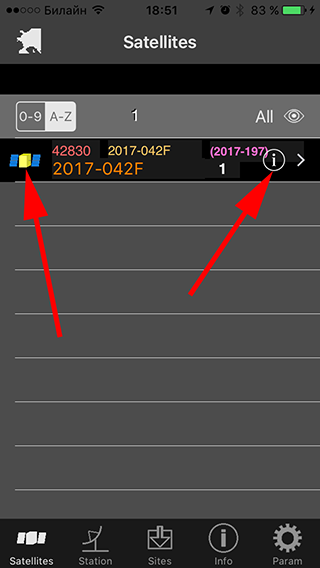
Now visible spans are displayed, on the left - the start time of the span and the end time of the observation. Clicking on the line with a specific span, you can put a reminder.

And finally, let's see how he will fly, from where and where.
Go to the “Station” tab, and in the upper left corner click on the map icon.

A (somewhat strange) map will appear. At the top is the time and date, and at the bottom there is a scroller with a time scale (working the other way around). You can, running your finger on the scroll, change the time and see how and where the satellite is flying. By clicking on the satellite itself, its trajectory will be shown, and from the top-right in the menu the satellite icon - by clicking on it, you can show the remaining orbital segments. The map view can be changed by the second left icon in the top row.

A map of the sky with an orbit (you can rotate with your finger) and a general map of the sky.
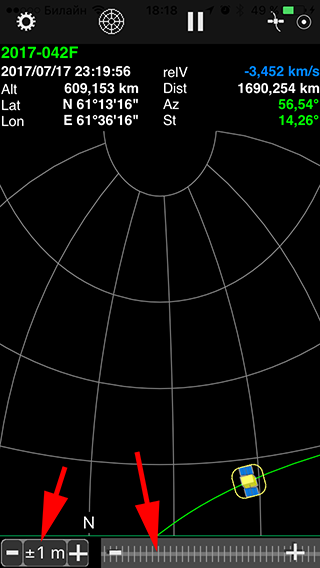
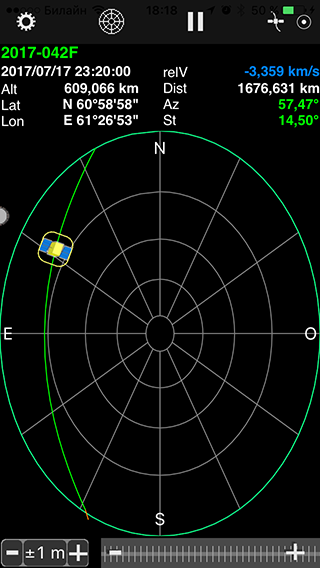

Scroll down the list to the record “Last 30 days launches” (this is the device from the last launches in 30 days) and go to it.

Click on the “refresh” icon at the top, the download of the database of recently launched satellites will begin.

Enter in the search box ID Beacon - 2017-042F
We click on the empty field on the right, a check mark appears.

Everything, now the application is configured to display our satellite!
Next, we need to specify a point on the globe where we are. Go to the Station tab below.
By default there are Cupertino and Paris - click “Edit”.

We demolish Cupertino and Paris (if you are, of course, not there) and click “New Station” (meaning observation station).

We click on the location icon (iphone will ask to enable geolocation detection - we allow), we wait until the coordinates are determined, after a couple of seconds we press the “Save” button.

Now let's see the time of the visible passage of the Beacon over our location.
To do this, go to the “Satellites” tab, one of our satellites will be displayed there (and the ISS, if you have not deleted it). Make sure there is a yellow-blue satellite icon to the left of the Beacon - this displays it on the map. If not, click to the left of the name, then click on the “i” icon to the right of the satellite.

Now visible spans are displayed, on the left - the start time of the span and the end time of the observation. Clicking on the line with a specific span, you can put a reminder.

And finally, let's see how he will fly, from where and where.
Go to the “Station” tab, and in the upper left corner click on the map icon.

A (somewhat strange) map will appear. At the top is the time and date, and at the bottom there is a scroller with a time scale (working the other way around). You can, running your finger on the scroll, change the time and see how and where the satellite is flying. By clicking on the satellite itself, its trajectory will be shown, and from the top-right in the menu the satellite icon - by clicking on it, you can show the remaining orbital segments. The map view can be changed by the second left icon in the top row.

A map of the sky with an orbit (you can rotate with your finger) and a general map of the sky.


Web
For an Internet browser, you can use the resource: Heavens-Above (you need to select only 2017 and scroll to the very end of the list, page 13, Mayak ). The truth is that our satellite has so far assigned the designation 2017-042E , but we plan to contact our colleagues from this resource and find out what is the reason for this and correct the error.
In the very card of our satellite, the number is already correct 2017-042F . Here you can see the orbit and dates of the nearest visible flights above your location ( example for Moscow ).
Note: the magnitude of the star is indicated without considering the opened reflector.
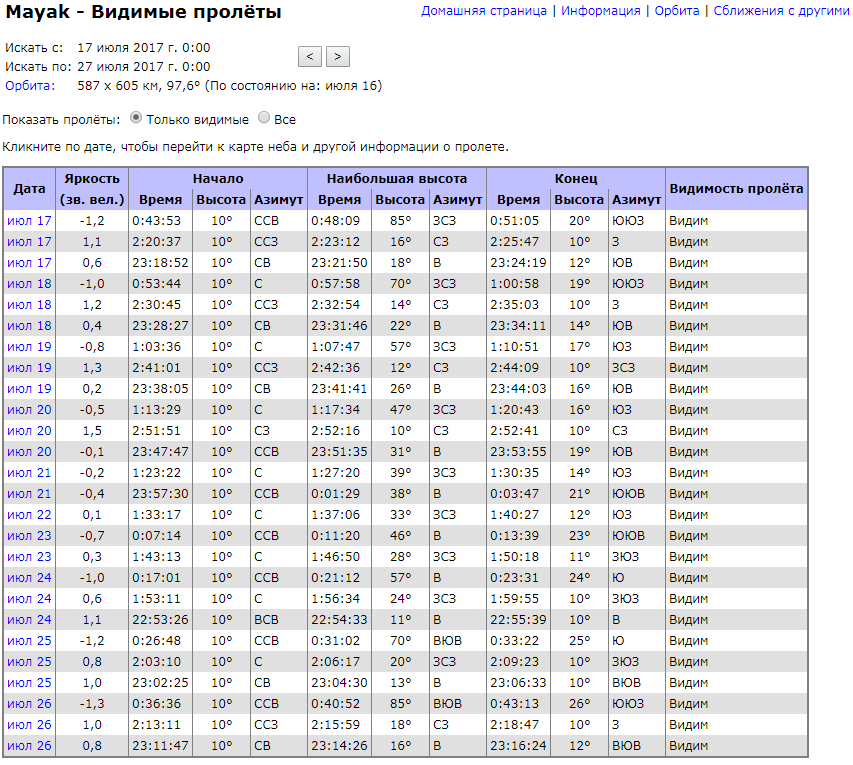
The location is indicated on the main page of the resource or here .
PC
For Windows, you can use the program Heavensat .
PS
The closest flight almost at the zenith for observation from Moscow and Moscow Region will happen right today at night , 07/18/2017 at 00:57:58
Trajectory in the sky:

The final!
We have completed our project. Successfully completed :) He was difficult and ambitious. We hope you find it interesting to watch us and our work.
Now our team takes a bit of breath and slowly considers the following projects ... But more on that later;) but for now you can look at the night sky ... there ...
We light the stars!
UPD:
The efforts of observers from Astroforum , colleagues working in the CAO and the Mini-MegaTORTORA
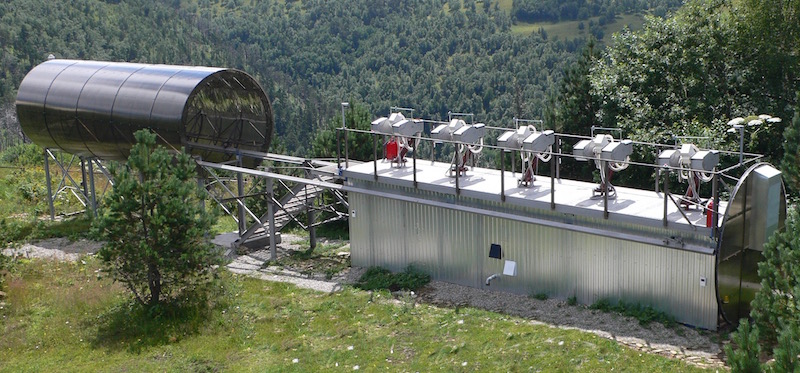
we received the first photos and videos of potential candidates for the LIGHTHOUSE (unfortunately, it is now known that this was not a lighthouse):
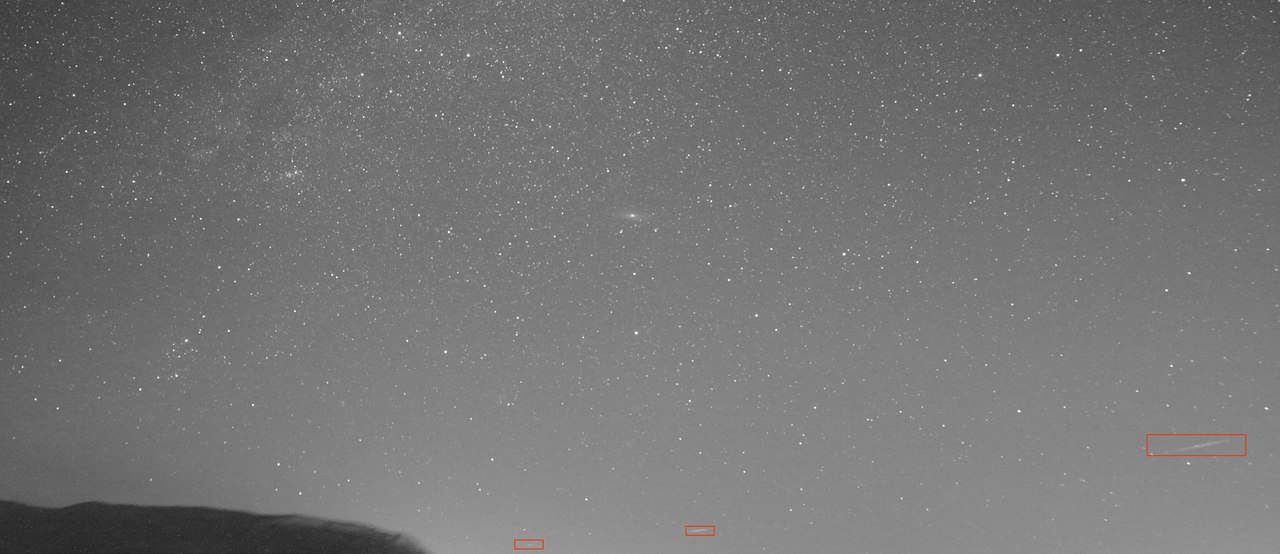
Photography - Evgeny Semenko, Ekaterina Semenova. Shooting location 43.887377, 41.523558.
More in a separate post , in the same place we will promptly update photos and video materials.
Considering that the first few TLEs, as a rule, do not contain accurate information, we continue to collect data together with the participants of the Summer Space School in order to calculate the exact orbital parameters of our satellite.
Special thanks to everyone who has the opportunity and joined the video recording of the BEACON in the sky!)
UPD2:
Dear friends.
On behalf of the leader of our project, a new article has been published with an analysis of the current situation with observations of the satellite Mayak and conclusions about its performance, unfortunately, not comforting.
The brief summary is as follows: “In short, we now believe that Mayak most likely did not reveal what is being observed now - these are other Kubsatas equipped with solar batteries glaring on the Sun.”
Link to article
All Articles